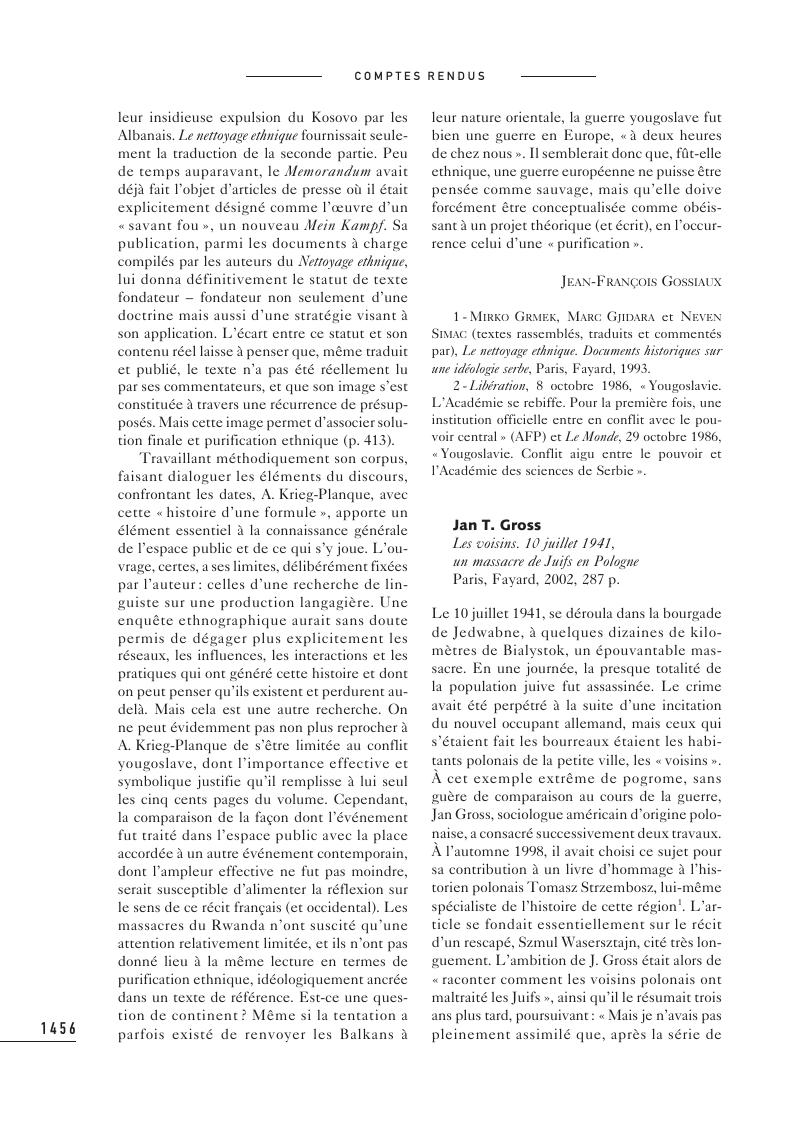No CrossRef data available.
Article contents
Jan T. Gross Les voisins. 10 juillet 1941, un massacre de Juifs en Pologne Paris, Fayard, 2002, 287 p.
Published online by Cambridge University Press: 04 May 2017
Abstract

- Type
- Europe centrale (comptes rendus)
- Information
- Copyright
- Copyright © Les Éditions de l’EHESS 2005
References
1- Jan T. Gross, « Lato 1941 w Jedwabnem. Przyczynek do badańnad udziałem społecznośći lokalnych w eksterminacji narodu ź ydowskiego w latach II wojny światowej » («Été 1941 a Jedwabne. Contribution aux recherches sur la participation des sociétés locales dans l’extermination du peuple juif pendant la Seconde Guerre mondiale »), in Jasiewicz, K. (éd.), Europa nieprowincjonalna (L’Europe non provinciale), Varsovie-Londres, Instytut Studiów Politycznych PAN/Oficyna Wydawnicza RYTM, 1999 Google Scholar (je remercie Agnieszka N. Niewiedzial-Bédu d’avoir bien voulu lire cet article pour moi).
2- Gross, Jan Tomasz, Sąsiedzi. Historia Zagłady Źydowskiego Miasteczka, Sejny, Fundacja Pogranicze, 2000.Google Scholar
3- Borkowicz, Jacek, Gutman, Israel et Brand, William R. (éd.), Thou shalt not kill. Poles on Jedwabne, Varsovie, Wiez, 2001 Google Scholar ; Henning, Ruth, Die « Jedwabne-Debatte » in polnischen Zeitungen und Zeitschriften, Potsdam, Deutsch-Polnische Gesellschaft Brandenburg e.V., 2001 Google Scholar ; Polonsky, Antony et Michlic, Joanna B. (éd.), The neighbors respond. The controversy over the Jedwabne massacre in Poland, Princeton, Princeton University Press, 2004 Google Scholar ; voir également le dossier «The Jedwabne controversy », Yad Vashem studies, XXX, 2002.
4- Machcewicz, Pawel et Persak, Krzysztof, Wokół Jedwabnego (Autour de Jedwabne), Varsovie, Instytut Pamięu ci Narodowej, 2002.Google Scholar
5- Levi, Primo, Les naufragés et les rescapés. Quarante ans apres Auschwitz, Paris, Gallimard, 1989, p. 82 Google Scholar sqq. Pour une analyse de la figure du « musulman », voir Agamben, Giorgio, Homo Sacer III. Ce qui reste d’Auschwitz. L’archive et le témoin, Paris, Rivages, 1999 Google Scholar, ainsi que l’article de Ginzburg, Carlo, « Beweis, Gedächtnis, Vergessen », Werkstattgeschichte, 2001 Google Scholar, « Memory-30 ». Voir aussi l’entreprise de collecte et de publication de témoignages de personnes déplacées, en particulier juives, menées a partir de 1946 par David Boder, dont le premier recueil s’intitule : « Je n’ai pas interrogé les morts » ( Boder, David, I did not interview the dead, Urbana, University of Illinois Press, 1949, traduction à paraître en 2006 chez TallandierCrossRefGoogle Scholar).
6- Ginzburg, Carlo, « Just one witness », in Friedlander, S. (éd.), Probing the limits of representation: Nazism and the final solution, Cambridge, Harvard University Press, 1992, pp. 82–96.Google Scholar
7- Goldhagen, Daniel J., Les bourreaux volontaires de Hitler. Les Allemands ordinaires et l’Holocauste, Paris, Le Seuil, [1996] 1997 Google Scholar ; sur l’exposition de Hamburg, voir Verbrechen der Wehrmacht. Dimen sionen des Vernichtungskrieges 1941-1944, Hambourg, Hamburger Édition, 1995, et Eine Ausstellung und ihre Folgen. Zur Rezeption der Ausstellung « Vernichtungskrieg. Verbrechen der Wehrmacht 1941 bis 1944 », Hambourg, Hamburger Edition, 1997. Voir également Heribert Prantl (éd.), « Wehrmachtsverbrechen ». Eine deutsche Kontroverse. Hambourg, Hoffmann und Campe, 1997. Il me semble que l’on pourrait, dans un tout autre genre, intégrer a la meme série les (faux) mémoires de Binjamin Wilkomirski, Fragments. Une enfance 1939-1948 (Paris, Calmann- Lévy, 1997) tant il est vrai qu’ils se déploient tout entier dans le registre de la cruauté gratuite, de l’atrocité. Sur le cas Wilkomirski, voir Lappin, Elena, L’homme qui avait deux tetes, Paris, Éditions de l’Olivier, 2000 Google Scholar, et Maechler, Stefan, The Wilkomirski affair. A study in biographical truth, New York, Schocken, 2001.Google Scholar




